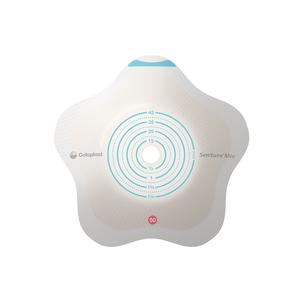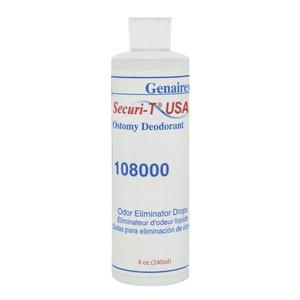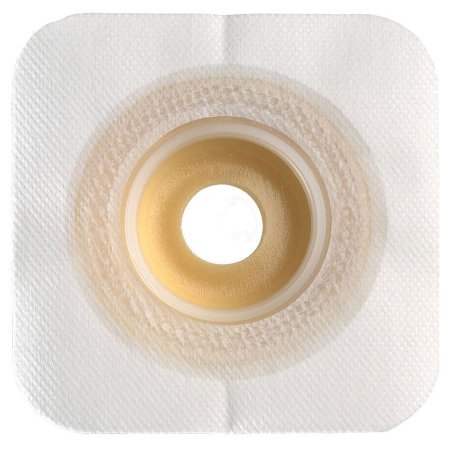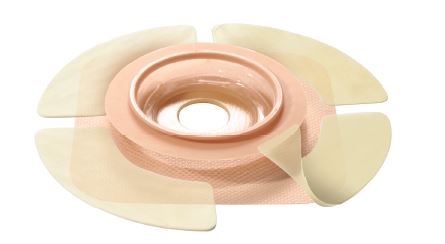Having an ostomy can challenge a person’s lifestyle in a variety of ways. Any time we experience changes to what we are familiar with, daily life can become frustrating. Thankfully, there are helpful tips for many of the most common ostomy concerns to make managing life with an ostomy easier. With the right ostomy supplies, most people can live a comfortable and active life.
So, here are some of the most asked questions regarding common ostomy concerns, along with tips and answers that may be helpful.
Why isn’t my ostomy pouching system staying in place?
One of the most common reasons why an ostomy pouching system is not staying in place is due to an improperly fitting skin barrier. If the ostomy pouch doesn’t conform snugly to the peristomal skin, leakage is a risk.
Here are a few tips you might try to correct this common ostomy concern.
Make sure your skin barrier is the right fit.
There are many skin barriers available today that allow for a comfortable and snug fit around the stoma. There are convex skin barriers that curve outward toward the skin to create a better seal, and there are moldable skin barriers that allow a more personalized fit, requiring no cutting. Making sure your skin barrier is the right fit can help avoid a common ostomy concern of your pouch not staying in place as you move about throughout your day.
Make sure your skin is dry before applying your skin barrier.
When the skin is wet or moist, it can be more challenging to achieve a good seal. Without a tight seal, the risk of skin irritations and leaks increases. Ostomy supplies such as stoma powder can absorb moisture and keep the peristomal skin dry and protected.
Try using an ostomy belt or wrap.
 Ostomy belts and wraps help to keep an ostomy pouching system securely in place. Many ostomy pouching systems feature belt tabs for support belts that are easily adjustable to fit all sizes.
Ostomy belts and wraps help to keep an ostomy pouching system securely in place. Many ostomy pouching systems feature belt tabs for support belts that are easily adjustable to fit all sizes.
Another type of ostomy belt or support wrap offered is wide enough to cover more area of the ostomy pouching system. This type of ostomy belt typically features either a Velcro closure or hook-and-loop closure that adjusts to get the desired fit. These support belts have a circular opening in a non-stretchable area of the belt for barrier and pouch support.
Bonus tip:
Make sure to empty your ostomy pouch before you head out, exercise, or engage in sexual activity. If the pouch is full, it can become heavy and pull away from the skin barrier, resulting in leaks, which is another common ostomy concern.
Why is my ostomy pouch filling up with gas so often?
When an ostomy pouch fills with gas or “wind,” it is usually due to the filter becoming blocked. Moisture can cause a blockage as well as stoma output. The pressure created from the ostomy pouch filling up with gas can be another reason the ostomy pouch is coming away from the body, resulting in leaks.
Here are a few tips that might help reduce the common ostomy concern of an ostomy pouch filling up with gas as often.
Consider using a ventilation accessory.
Many ostomy supplies can help control the buildup of gas in an ostomy pouch. A popular choice is the Osto-EZ-Vent device for any type of ostomy pouch. The Osto-EZ-Vent is an excellent alternative to burping or opening the bottom of an ostomy pouch to release the air. It is easy to install, works efficiently, lasts as long as the ostomy pouch is worn, and is not affected by water.
Try avoiding gas-inducing foods.
Spicy foods and some vegetables such as cabbage, corn, spinach, broccoli, and onions can produce more gas. Carbonated or fizzy beverages such as sodas, sparkling water, and beer are also more gaseous and should be avoided as much as possible. It is essential to include a variety of vegetables in your diet; however, taking smaller bites and chewing slowly can help reduce the amount of air ingested while eating.
Avoid chewing gum and smoking.
Chewing gum and smoking are two actions that increase the amount of air you ingest and can contribute to your ostomy pouch filling with gas more often. Avoiding these habits can help reduce gas buildup in your pouch.
How can I control embarrassing odors coming from my ostomy pouch?
Another common ostomy concern we hear a lot is that of an odor coming from the ostomy pouch. Odors coming from your ostomy pouch can be caused by burping your pouch to relieve excess gas, or they can be caused by leakage. We will discuss more about leakage later in this article and focus now on your options for controlling odors coming from a properly fitting ostomy pouching system.
Try a lubricating deodorant.
Ostomy lubricating deodorants help control smells in the ostomy pouch. This ostomy accessory can help neutralize odors as the ostomy pouch is emptied and keep output at the bottom of the ostomy pouch instead of gathering near the stoma.
Try using an ostomy pouch that features a filter.
By using an ostomy pouch that features a filter, odors caused by gas are neutralized. It is essential to keep an eye on the filter to avoid any blockage from output or water that could allow the ostomy pouching to lift and release odors, potentially leading to leakage.
Ostomy pouch filters are also sold as separate individual ostomy supplies aside from the pouch itself. The Coloplast Filtrodor Pouch Filter is charcoal-activated and self-seals to any ostomy pouch to protect against stoma output odors.
Consider using Diamonds Gelling and Odor Control Sachets.
 Diamonds Odor Control Sachets are dissolvable sachets that are designed as a single ostomy pouch treatment. One sachet is inserted through the drainage outlet or the wafer hole. Once the Diamonds sachet dissolves, liquid contents are solidified, reducing or eliminating gas and ballooning. Diamonds sachets are typically used at nighttime to help aid in a restful and uninterrupted night’s sleep.
Diamonds Odor Control Sachets are dissolvable sachets that are designed as a single ostomy pouch treatment. One sachet is inserted through the drainage outlet or the wafer hole. Once the Diamonds sachet dissolves, liquid contents are solidified, reducing or eliminating gas and ballooning. Diamonds sachets are typically used at nighttime to help aid in a restful and uninterrupted night’s sleep.
Learn more about Diamonds Gelling and Odor Control Sachets by clicking here: Diamonds FAQs.
Why do I have a rash on the skin around my stoma?
Peristomal skin should be smooth and healthy, just like the rest of the skin on the body. Redness, rash, or other irritation is another common ostomy concern that should be addressed and treated immediately to lessen the worsening of the problem. Your skin rash or irritation could be due to the peristomal skin repeatedly being exposed to feces, urine, or other bodily fluids from a poor fitting ostomy pouching system. Or, the skin irritation could result from frequent pouch changes or sensitivity to the adhesives used in some ostomy supplies.
Here are a few tips for managing rashes, redness, and other peristomal skin irritations.
Check the fit of your skin barrier and ostomy pouch.
As we have mentioned a few times in this article, the proper snug fit of the skin barrier can prevent many common ostomy concerns. At the same time, if the ostomy pouch opening is too large for the skin barrier, fluids and waste will be allowed to contact the peristomal skin and not sufficiently drain. If adjustments are needed throughout the day, the skin will only become more irritated. The more your ostomy pouching system rubs against your skin, the more risk for trauma to the area. It may be helpful to check the size and shape of your stoma regularly to assure you have the correct fitting ostomy pouching system.
Consult with your doctor about the adhesives in the ostomy supplies you are using.
 Sometimes, the adhesives used in the ostomy supplies you are using can contribute to the peristomal skin irritation you are experiencing. You might have a sensitivity to the adhesive, and your doctor may be able to confirm that by sharing what ostomy supplies you are using. A minor rash or irritation could become something of more concern if left untreated. A simple change of the ostomy supplies you are using could be the solution to maintaining healthy peristomal skin.
Sometimes, the adhesives used in the ostomy supplies you are using can contribute to the peristomal skin irritation you are experiencing. You might have a sensitivity to the adhesive, and your doctor may be able to confirm that by sharing what ostomy supplies you are using. A minor rash or irritation could become something of more concern if left untreated. A simple change of the ostomy supplies you are using could be the solution to maintaining healthy peristomal skin.
Assess any potential changes in your output.
Has there been a change in your output? Has your stool become more loose or watery? If so, try changing to a drainable pouch if you are using a closed-end pouch. You might be able to manage the frequency of changing your ostomy pouching system better. Fewer changes mean less skin irritation. A drainable ostomy pouch can stay in place as it is emptied. And, better yet, opting for a two-piece ostomy pouching system can allow the skin barrier to remain in place as the ostomy pouch is replaced. Your peristomal skin will stay healthier in the long run.
Help! I keep experiencing leakage with my ostomy pouching system. What can I do?
Leakages from your ostomy pouch can occur for a variety of reasons and this is one of the most common ostomy concerns. After stoma surgery, the abdominal shape changes for some time, affecting the stoma size. Checking your stoma regularly can help avoid improperly fitting skin barriers and ostomy pouches that can lead to leaks.
Here are a few tips for preventing leakage from your ostomy pouching system.
Try a convex or moldable skin barrier.
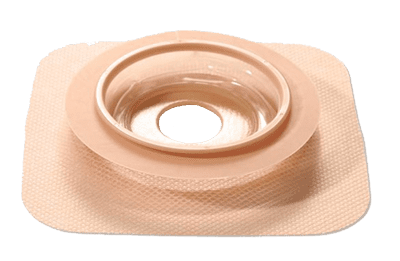 As mentioned previously in this article, a convex skin barrier can help create a better seal to prevent leaks. If there has been a change in the protrusion of your stoma or the peristomal skin is irregular, using a convex skin barrier might be beneficial. A moldable skin barrier is made of creates a secure seal around the stoma that doesn’t require the use of any scissors.
As mentioned previously in this article, a convex skin barrier can help create a better seal to prevent leaks. If there has been a change in the protrusion of your stoma or the peristomal skin is irregular, using a convex skin barrier might be beneficial. A moldable skin barrier is made of creates a secure seal around the stoma that doesn’t require the use of any scissors.
Monitor for changes in your output.
A change in your output can also cause concerns with leakage. Stoma output that has become loose or watery can often be the precursor to leakage from your ostomy pouching system. The moisture and wetness that builds up between the peristomal skin and the barrier can lead to skin irritation and soreness.
Try applying a secondary adhesive.
Another option to keep your ostomy pouching system from leaking would be to apply a secondary adhesive. Hy-Tape is a popular choice to add as a second layer of protection from leakage. Hy-Tape is a thin, latex-free, waterproof, and conforming adhesive that makes it easier to create a seal around the skin barrier. This secondary adhesive is an excellent solution for sensitive skin or those who have irritation surrounding the stoma. Hy-Tape holds firm but releases gently without becoming stickier as body temperature rises. Peristomal skin is left intact and healthy due to the zinc-oxide-based formula.
What pouching options do I have if discreetness is my concern?
As we have learned, when an ostomy pouch fills with gas or wind, it will become more apparent underneath clothing as it starts to balloon. Using a pouch that features a filter or an ostomy accessory such as a ventilation device, this gas can be released, and the ostomy pouch will deflate.
There are a few tips when discreetness is of concern.
Try emptying your pouch more often.
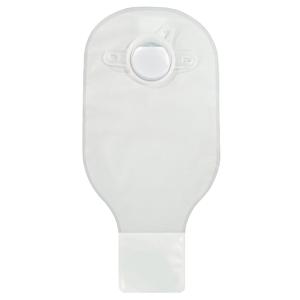 An ostomy pouch full of output will bulge more and be less discreet. By keeping an eye on the ostomy pouch contents, you can drain the output and keep a flatter pouch. There are transparent drainable ostomy pouches such as the Hollister Securi-T Two-Piece Drainable Pouch. Not only is this ostomy pouch transparent for viewing contents, it is drainable, features a filter to deodorize gas, but it is part of a two-piece system that offers stoma protection by reducing pouch changes.
An ostomy pouch full of output will bulge more and be less discreet. By keeping an eye on the ostomy pouch contents, you can drain the output and keep a flatter pouch. There are transparent drainable ostomy pouches such as the Hollister Securi-T Two-Piece Drainable Pouch. Not only is this ostomy pouch transparent for viewing contents, it is drainable, features a filter to deodorize gas, but it is part of a two-piece system that offers stoma protection by reducing pouch changes.
Consider the color of the ostomy pouch film.
Nowadays, ostomy pouches are made in a variety of pouch film options. You might consider a beige or opaque film that can offer more discreetness than a transparent or clear ostomy pouch. The beige color matches the skin more closely and can help conceal the contents of the pouch more easily. However, it is essential to note that monitoring the output in a beige or opaque ostomy pouch is more difficult than a transparent or clear one.
Consider a stoma cap if you have mastered managing your output.
If you have predictable and relatively infrequent bowel movements, a stoma cap may be an option for you. A stoma cap is the smallest of all ostomy pouch options. It is approximately 3-4 inches across and the most discreet pouching option available. Stoma caps are a popular choice when participating in activities such as swimming, working out, playing sports, intimacy, or irrigation. These ostomy supplies are not recommended for those with ileostomies or unpredictable output as they are not ideal for more significant amounts of liquid or formed stool.
You can learn more about stoma caps, their uses, and if they might be the right choice for you in our A Stoma Cap and its Many Uses blog post.
These are only a handful of the common ostomy concerns that ostomates experience. Hopefully, we have provided some valuable tips for some of the most common concerns we have heard. If you are experiencing these or other problems with your ostomy, first consult with your doctor. Then, we can help you find the products recommended or provide additional suggestions based on your doctor’s findings. Our Product Experts are here to assist and help make your life a little easier.

